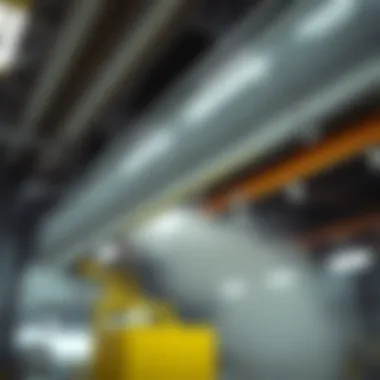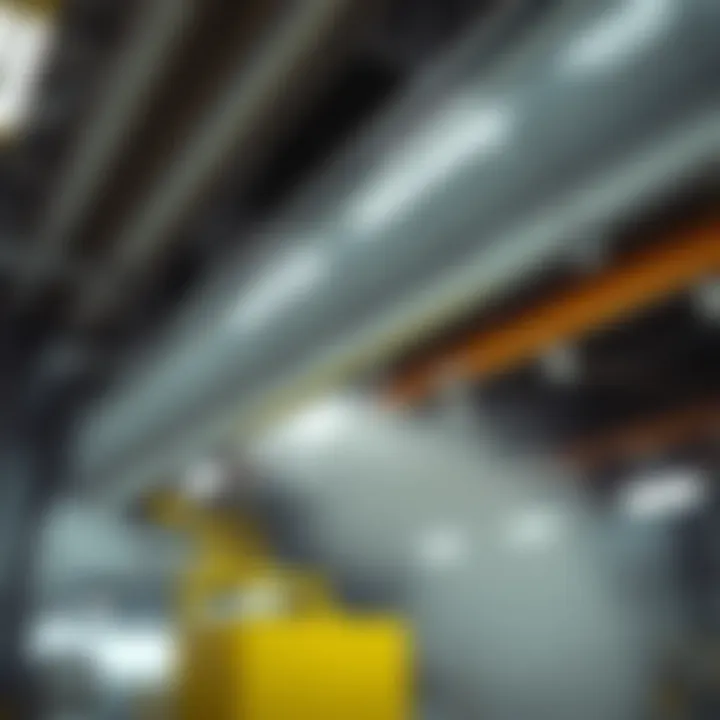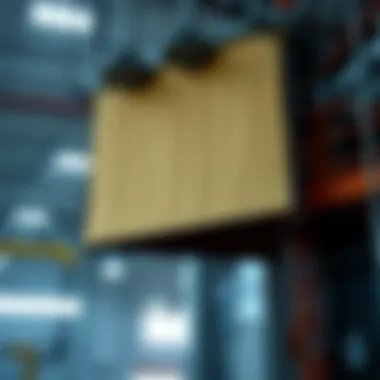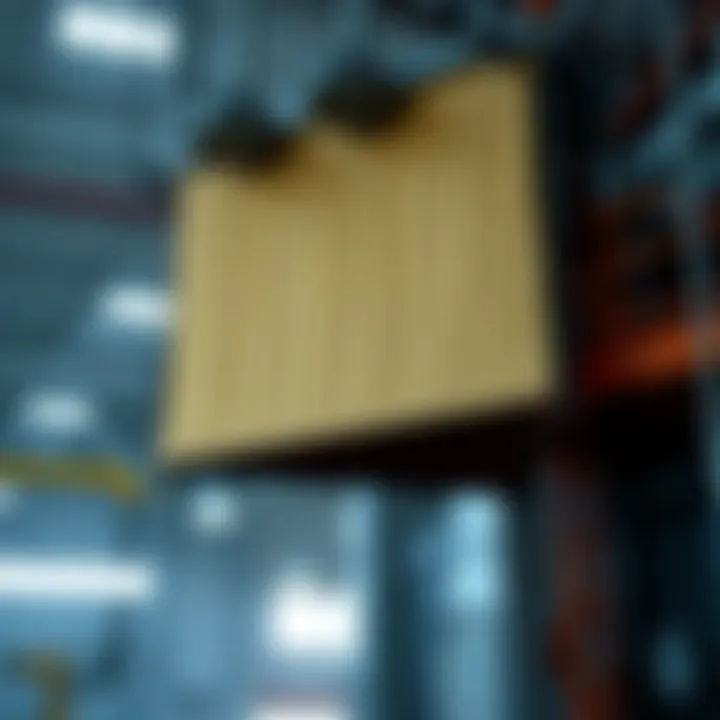Industrial Dust Curtains: Enhancing Safety and Efficiency


Intro
In the bustling world of industrial operations, maintaining a safe and efficient workspace is paramount. One of the unsung heroes in achieving this ideal is the industrial dust curtain. These practical solutions play a vital role in controlling airborne particles, preserving air quality, and creating safer environments. Understanding the functionality, benefits, and various applications of dust curtains is essential for anyone involved in the industrial sector, from management to on-the-ground teams. This guide will delve deep into how these structures can significantly bolster operational performance and worker safety.
Key Concepts and Terminology
Definition of Key Terms
Industrial Dust Curtain refers to a fabric barrier designed to contain dust, debris, and other airborne contaminants in an industrial setting. They act as shields, either partially or fully enclosing a designated area to mitigate the dispersal of these particles into the larger environment, thus maintaining cleaner air quality.
Concepts Explored in the Article
- Material Selection: Different fabrics and materials are used based on the specific requirements of the industry, ensuring durability and effectiveness in various conditions.
- Installation Techniques: Proper installation methods are crucial for maximizing the protective qualities of dust curtains. This includes understanding the spatial dynamics of the work environment.
- Benefits: The advantages of implementing these curtains extend beyond mere containment, providing enhancements in safety protocols, regulatory compliance, and overall operational efficiency.
- Best Practices: Insights into effective implementation strategies will also be discussed, offering practical guidance for organizations aiming to leverage dust curtains to their full potential.
Findings and Discussion
Main Findings
Dust curtains serve as a vital line of defense against airborne dust and debris, offering multiple benefits:
- Air Quality Control: By containing dust, these curtains help in cleaning the air that workers breathe, reducing health risks related to respiratory issues.
- Cost-Effectiveness: They present a financially wise alternative to complex ventilation systems, often yielding better results without overspending.
- Safety Improvement: Providing clear visual barriers helps reduce accidents, especially in heavy machinery environments where visibility is essential.
Potential Areas for Future Research
While there's a robust understanding of dust curtains, further research could explore:
- Advanced materials that enhance durability while reducing environmental impact.
- Long-term studies on how effective they are in various industries and conditions.
- Innovations in smart dust curtain technologies, perhaps combining IoT solutions to monitor air quality in real-time.
"Industrial dust curtains are more than just barriers; they are essential components in the pursuit of a safe and efficient working environment."
By examining the ins and outs of these structures, we can forge a path towards better practices in dust management, which is increasingly crucial in today's industrial landscape. Exploring the technical nuances, applications, and best practices for dust curtains offers valuable insights applicable to a range of industries, making it a topic worthy of attention.
Understanding Industrial Dust Curtains
Understanding the concept of industrial dust curtains is crucial for anyone engaged in sectors where dust and particulate matter pose health and safety risks. These curtains act as barriers, creating designated areas that help contain dust and promote air quality control. In industries like manufacturing, food processing, and construction, managing dust is not just a regulatory requirement; it’s also a matter of worker safety and productivity. The utilization of dust curtains leads to a cleaner work environment, which can directly influence the efficiency of operations.
Definition and Purpose
Industrial dust curtains are flexible partitions made from various materials designed to control dust, debris, and other airborne particles in industrial environments. Their primary purpose is to segregate areas within a facility, preventing the spread of dust from one area to another. This segregation is pivotal for minimizing exposure to workers and aiding in compliance with occupational health regulations.
The purpose of dust curtains can be understood through several core functions:
- Air Quality Improvement: They help filter out unwanted particles from the air, improving indoor air quality by limiting dust migration.
- Enclosure of Work Zones: They create controlled zones where specific tasks can be performed without contaminating the surrounding environment.
- Temperature Regulation: Besides their role in dust containment, they also aid in maintaining temperature differences between various sections of a facility, which can be key to process efficiency.
In essence, these curtains are not just physical barriers; they serve a functional role in the overall operational strategy of many industries.
Historical Development
The evolution of industrial dust curtains gives insight into the changing dynamics of workplace safety and environmental management. Initially, dust control measures in industries were rudimentary at best. Often, simply using makeshift barriers or manual cleaning methods proved insufficient.
As awareness about workplace safety increased, especially through the latter half of the 20th century, the need for more effective solutions was recognized. Manufacturers began experimenting with various materials and designs, leading to significant advancements. Early versions involved simple canvas or cloth barriers, which were not very durable or effective.
With advancements in material science, particularly the introduction of synthetic materials like PVC and polyethylene in the late 1980s, dust curtains experienced a paradigm shift. These materials offered higher durability, flexibility, and better resistance to environmental factors. Therefore, dust curtains became a standard fixture in many industrial settings.
Today, innovations continue to emerge, with manufacturers focusing on enhancing the thermal and acoustic properties of dust curtains. As regulatory frameworks also evolve, the focus remains on creating solutions that not only improve air quality but also ensure compliance with health and safety regulations.
"The path to ideal industrial safety is paved with consistent practices in dust management. Dust curtains are often the unsung heroes in achieving this goal."
Understanding the historical context of dust curtains underlines their significance today. It's not just about aesthetics or temporary fixes; it's about creating lasting solutions that protect workers and enhance operational efficiency.
Types of Industrial Dust Curtains
When we talk about industrial dust curtains, it’s vital to understand that not all dust curtains are created equal. Each type has its unique properties, benefits, and considerations that make it suitable for specific applications and environments. Selecting the right kind of dust curtain can significantly impact overall efficacy in controlling dust and maintaining a healthier work environment. Let's break down the major types of industrial dust curtains so that you can make informed decisions tailored to your unique needs.
Flexible Vinyl Curtains
Flexible vinyl curtains are often regarded as the workhorses of dust control. Made from soft, flexible materials, these curtains are designed to withstand regular wear and tear while providing a barrier against airborne particles. What makes them particularly appealing is their adaptability; they can be custom-cut to fit any space and are easy to install.
- Benefits: They are excellent for controlling airborne dust and debris, offering a clear visual separation from hazardous areas without obstructing vision. Furthermore, their resilience allows them to perform well in various temperatures and humidity levels. They usually come in different thicknesses, making them versatile for light-duty to more rigorous applications.
- Considerations: However, they do require regular upkeep. Over time, exposure to environmental elements can affect their durability. Users should inspect these curtains routinely for wear and proper sealing.
Mesh Curtains


Mesh curtains introduce a different angle to dust management solutions. Crafted from woven fabrics, these curtains promote airflow while still providing some level of dust control. They are often used in applications where ventilation is a must, like warehouses or workshops.
- Benefits: The breathable nature of mesh materials helps maintain air circulation, reducing stuffiness in confined areas. Plus, they are generally lightweight, which aids in ease of handling and installation, offering simple access to openings without needing to remove the curtain.
- Considerations: However, with that added airflow comes a trade-off—mesh curtains may not offer as much dust filtration effectiveness as their vinyl counterparts. They are better suited for environments where dust control is important but not critical, often working best as a secondary layer of protection.
Heavy-Duty Curtains
For industrial professionals dealing with highly polluted environments, heavy-duty curtains are a must-have. Constructed with thick materials, these curtains are built to endure some of the more brutal conditions in manufacturing, construction, or heavy-duty cleaning areas.
- Benefits: They offer superior dust containment and are often reinforced with additional features like grommets and reinforced seams for added durability. These curtains can easily handle industrial machinery, frequent traffic, and harsh chemicals, making them an investment worth considering for long-term use.
- Considerations: On the downside, the weight of heavy-duty curtains can complicate installation, often requiring specialized hardware or professional assistance. Their robust nature may also lead to increased costs compared to lighter curtain options.
By exploring the various types of industrial dust curtains, one can better appreciate the nuanced requirements of differing environments. Every choice from flexible vinyl to mesh and heavy-duty curtains can shape a workspace's air quality and overall safety. Finding the right one for your needs stands to enhance operational efficiency and worker wellbeing.
Materials Used in Dust Curtains
The selection of materials utilized in industrial dust curtains holds significant weight in their effectiveness and operational viability. Understanding the various types of materials is fundamental for any professional engaged in dust management strategies. Two prevalent materials are PVC and polyethylene, both of which offer distinct properties and applications tailored to various industrial needs. Their characteristics can dramatically influence everything from durability and maintenance to the overall efficiency of dust containment.
The choice of material impacts not only how well dust is kept at bay but also how long the curtains will last in demanding environments. Factors such as temperature fluctuations, exposure to chemicals, and physical wear and tear all necessitate careful consideration in the selection process. In this section, we will take a closer look at the two primary materials used in dust curtains, exploring their properties and advantages.
PVC and Its Properties
Polyvinyl chloride, or PVC, is a mainstay in the production of dust curtains. Known for its excellent durability, PVC can withstand harsh conditions, making it suitable for environments where exposure to chemicals or heat is commonplace. It is resistant to abrasion, ensuring that it stands the test of time even in high-traffic areas.
A significant feature of PVC is its versatility. It can be manufactured in a variety of thicknesses and transparencies, providing options suited to different industry needs. For instance, thicker PVC curtains can provide superior dust and air control but might inhibit visibility. Conversely, thinner variants allow for more light while still offering basic dust protection.
Some further essential properties of PVC include:
- Water Resistance: This property helps in maintaining structural integrity under wet conditions.
- Ease of Maintenance: PVC curtains can be easily cleaned and are resistant to various contaminants.
- Cost-Effectiveness: Compared to some alternatives, PVC is relatively inexpensive and widely available, making it a popular choice.
Polyethylene Options
Polyethylene, another common choice for dust curtains, is lightweight and flexible, giving it an edge in various applications. Unlike PVC, polyethylene can offer better insulation properties and is often favored in temperature-controlled environments. This approach helps to reduce energy costs while maintaining external conditions.
There are several forms of polyethylene used for curtains, including low-density and high-density options. Low-density polyethylene is softer and more pliable, which makes it ideal for construction sites requiring frequent access. High-density polyethylene, on the other hand, provides more rigidity and strength but may lack the flexibility required for certain applications.
Key characteristics of polyethylene include:
- Environmental Resistance: It offers a good degree of resistance to UV light, ideal for outdoor applications.
- Recyclability: This material can often be recycled, appealing to eco-conscious companies.
- Energy Efficiency: Providing good thermal insulation, polyethylene can contribute to lower heating and cooling costs.
"Choosing the right material for dust curtains is much like picking the right tool for a job: the right fit makes all the difference in effectiveness and longevity."
For more insights into material choices, consider exploring resources from Wikipedia or relevant industry publications.
Installation Methods
Installation methods for industrial dust curtains play a crucial role in the effectiveness of dust control measures. Correct installation ensures that curtains serve their intended purpose, minimizing dust migration and improving air quality. A proper installation process also extends the life of the curtains, preventing premature wear and tear. This section explores two critical components of installation: site assessment and hanging techniques.
Site Assessment
Before any installation, a thorough site assessment is paramount. Understanding the environment where the dust curtains will be installed is vital to ensure they function optimally. It involves evaluating multiple factors:
- Airflow Patterns: Knowing how air moves throughout the space can influence curtain placement. For instance, if dust is generated from a specific point, align the curtain accordingly to intercept the airborne particles.
- Foot Traffic: Areas with high foot traffic may require different durable options compared to less trafficked zones. This assessment will help choose appropriate curtain materials and styles.
- Installation Height and Width: Measurements must be meticulous. Curtains should run the full length of the opening they cover, and clearances must be taken into account to prevent dust from bypassing the barrier.
Conducting this initial inspection will not only identify potential challenges but will also streamline the installation process. Ignoring thorough assessment can lead to costly errors and reduced effectiveness of the system.
Hanging Techniques
Choosing the right hanging techniques is fundamental to ensure your dust curtains maintain their stance against dust and contaminants. Various methods can be used depending on the structure and particular needs of each setup:
- Track Systems: A common method involves using a track system for easy movement. This is beneficial in spaces that require changing configurations; curtains can be drawn aside when not needed.
- Direct Mounts: In situations where the curtain needs to be more permanent and static, direct mounting to walls or ceilings can provide robustness. This method reduces the risk of curtains shifting or being accidentally moved.
- Weighted Bottoms: Adding weights to the bottom of the curtains keeps them anchored to the ground, minimizing the chances of wind or airflow disrupting their placement.
When applying hanging methods, it’s essential to ensure that any fasteners used are appropriate for the material of the walls or ceilings. Fasteners failing due to mismatched materials could result in curtains falling, which would compromise air quality.
Proper installation of dust curtains greatly enhances their efficacy, ensuring a cleaner and safer work environment. Taking the time to assess the site and select suitable hanging techniques pays dividends in maintaining air quality and safety.
For further resources related to best installation practices, consider visiting:
- U.S. Occupational Safety and Health Administration (OSHA)
- International Safety Equipment Association (ISEA)
- Wikipedia on Dust Control
Taking these steps helps ensure successful dust management strategies through the strategic installation of dust curtains.
Benefits of Using Dust Curtains
Understanding the benefits of industrial dust curtains is crucial for anyone involved in environments where dust and debris are part of the daily operations. These benefits extend beyond just keeping areas tidy; they encompass health considerations, cost savings, and overall operational efficiency. Properly implemented dust curtains can significantly improve air quality, enhance worker safety, and even lead to energy savings, making them an essential component of many industrial spaces.


Air Quality Control
One of the primary motivations for installing dust curtains is air quality control. In industrial settings, airborne dust can create a multitude of health problems for workers, ranging from minor irritations to severe respiratory issues. Controlling dust emissions should be treated as a top priority.
Dust curtains act as a barrier that helps contain dust particles, preventing them from spreading throughout the facility. By isolating dust-generating activities, these curtains contribute to lower levels of airborne contaminants. This is particularly important in sectors like manufacturing or construction, where heavy machinery may stir up significant amounts of dust.
"Effective air quality management in industrial settings leads to fewer health-related absences and promotes a more productive workforce."
Companies that prioritize air quality often see fewer health issues among employees, resulting in lower insurance costs and reduced liability. In an age where health and safety regulations are increasingly stringent, sticking to high air quality standards can keep a company ahead of the curve.
Worker Safety Enhancement
Another vital aspect of dust curtains is their role in worker safety enhancement. Industrial workplaces often expose employees to hazardous materials and conditions. By trapping dust and particles, these curtains help to create a cleaner work environment. This not only protects workers but also aligns with occupational health and safety guidelines.
Moreover, when dust is minimized, visibility improves, and the workplace feels safer and more organized. Workers can focus on their tasks without the constant threat of dust-related accidents, such as tripping hazards or loss of visibility. Enhanced safety measures can translate to increased employee morale and retention.
In addition, providing a clear delineation between clean and dirty areas helps in maintaining protocols for handling materials that may contain harmful substances. Using dust curtains as part of a comprehensive safety strategy can significantly mitigate risks, ensuring that employees are protected at all times.
Energy Efficiency
When it comes to energy efficiency, one might not immediately connect dust curtains with energy savings. However, these curtains can help maintain temperature control in industrial facilities. By acting as a barrier against dust and drafts, they allow heating and cooling systems to run more efficiently.
A controlled environment is not only more comfortable for employees but also reduces energy consumption. This can lead to substantial savings over time, especially in larger or climate-controlled facilities. Companies can significantly decrease energy expenditures by keeping conditioned air where it belongs.
Applications in Various Industries
The implementation of industrial dust curtains plays a crucial role across a variety of sectors. Understanding the specific applications can help stakeholders appreciate their significance not just for compliance, but for operational efficiency and safety. Depending on the industry, the practical use of dust curtains can vary, tailoring their function to suit different settings.
Manufacturing
In manufacturing environments, dust curtains serve as essential barriers against airborne particles that can impede operations and harm health. For instance, in facilities like metalworking shops and woodworking establishments, the dust generated from processes can be detrimental. Moreover, adequate dust control is not just a matter of aesthetics; it can significantly affect machinery maintenance and the longevity of equipment. When dust settles on machinery, it can lead to malfunctions and increased maintenance costs.
"Efficient dust management is as vital in manufacturing as oil is to an engine. Without it, everything grinds to a halt."
The positioning of dust curtains helps isolate work areas, allowing for localized control of the dust. This not only improves the air quality for workers but can also enhance productivity as team members can focus on tasks without the distraction or discomfort caused by dust. With tailored installation methods, depending on the layout of the manufacturing floor, flexibility in customizing the interventions becomes possible.
Construction
In the construction industry, dust becomes a major issue, especially during tasks like demolition, concrete cutting, or when handling dry materials. Not only does this create an unmanageable mess, but it can also pose significant health threats, particularly respiratory issues, for workers. Therefore, the proper application of dust curtains is imperative.
Frequently, construction sites are renowned for their chaotic atmosphere, where managing dust translates into safer and more organized workspaces. By enclosing areas where heavy dust is generated with dust curtains, both compliance with safety regulations and overall site cleanliness can be maintained. The temporary nature of these structures allows for adaptability as project specifications change.
Warehousing and Shipping
In warehousing and shipping operations, dust curtains play a dual role. Firstly, they help control dust from incoming and outgoing shipments, which often carry particles from various environments. Secondly, they help maintain a cleaner workspace by minimizing the amount of dust that can settle on inventory, preventing potential damage to products and ensuring that the items heading out to customers maintain a quality presentation.
Additionally, dust curtains in these facilities can also enhance other dust mitigation efforts, working alongside extraction systems. Their presence can help prevent dust from moving between different areas, such as production zones and storage areas. In essence, they contribute to optimizing processes and ensuring a higher standard of operations overall.
By identifying and leveraging these applications across different industries, businesses can make informed decisions that not only comply with regulations but also promote health, safety, and efficiency in operations. The diverse contexts in which dust curtains can be used underscore their versatility and importance in today’s industrial landscape.
For further reading on industrial applications, you might consider sources from Wikipedia on dust control or National Institute for Occupational Safety and Health.
Challenges in Dust Management
Dust management in industrial settings is not merely an operational concern; it’s a multifaceted challenge that addresses health, safety, and efficiency. Industrial dust curtains play a significant role in mitigating these challenges. However, the effective deployment of these curtains does not come without its own set of hurdles that must be surmounted.
Curtain Durability
Durability stands out as a fundamental element when discussing dust curtains. The very premise of using these curtains lies in their ability to withstand abrasive conditions typical of industrial environments. Materials used, such as PVC and polyethylene, bring their own strengths, yet factors like extreme weather or exposure to chemicals can compromise their longevity. For example, a facility situated near a warehouse that handles corrosive materials might find its dust curtains deteriorating faster than expected. As a result, regular assessments should be integral to any dust management strategy. This includes checking for tears or wear and upgrading to heavier-duty materials if necessary.
Further complicating this issue is the need for manufacturers to balance durability with cost. While spending a little more upfront on high-quality materials might seem excessive, in the long run, this investment can significantly cut down replacement costs and downtime. In essence, durability isn’t just an asset; it’s a necessity that can save a company from unnecessary expenses and hazards down the line.
Maintenance Requirements
Another layer of complexity in dust management revolves around maintenance requirements. Industrial dust curtains, while designed to reduce dust and contaminants, require routine maintenance to remain effective. If neglected, these curtains can harbor dust layers themselves, defeating their initial purpose. A well-maintained curtain not only does a better job at keeping out unwanted particles but also improves overall air quality and worker safety.
To streamline the maintenance process, establish a systematic schedule for inspections and cleaning. Ideally, this should happen at least once a month, depending on the dust levels in the surrounding environment. For instance, in construction zones where dust is pervasive, more frequent cleaning might be necessay. Users should also consider establishing clear guidelines for reporting any damages or maintenance needs.
Furthermore, training employees on proper handling techniques can also lead to prolonged lifespan and optimal performance of the curtains. This empowerment reduces the likelihood of accidental damages and promotes a culture of responsibility around equipment care.
"Investing in quality and maintenance not only safeguards employee health but enhances operational productivity in the long run."


Ultimately, addressing these challenges head-on allows organizations to maintain a functional and safe working environment. By focusing on strengthening curtain durability and committing to rigorous maintenance, firms can effectively navigate the intricate landscape of dust management.
Compiling Resources
For further information on the best practices concerning dust management solutions, industry leaders often turn to specialized resources. You can find valuable insights by visiting OSHA and EPA for regulatory guidance, while operational best practices discussions can be found on forums like Reddit. By actively engaging with these resources, stakeholders can stay ahead of emerging trends and techniques in dust management.
Best Practices for Implementation
Effective implementation of industrial dust curtains is essential for optimizing their functional benefits. The right practices not only prolong the lifespan of these curtains but also enhance their operational efficiency, thus ensuring cleaner air quality and improved safety in the workplace. Adhering to best practices can also facilitate compliance with industry regulations, making it easier for businesses to maintain standards.
Regular Inspections
Conducting regular inspections is critical in maintaining the integrity of dust curtains. It’s not just about ensuring that they look good; it’s about making certain that they function as intended. Inspections should cover several key aspects:
- Material Condition: Look for any signs of wear and tear. Particularly, check for punctures, tears, or fading, which could compromise the curtain’s effectiveness.
- Support Structures: Ensure that the hanging system remains stable. Any drooping or misalignment can lead to gaps, allowing dust to escape.
- Sealing Mechanisms: Examine the edges for any deterioration which may prevent a proper seal.
Regular inspections should ideally occur quarterly, but during peak operation periods, more frequent evaluations may be needed. It’s helpful to have a check-list ready to streamline this process.
Response Protocols for Failures
No system is flawless; hence having effective response protocols in place is crucial when failure occurs. Establishing a clear action plan ensures that issues are addressed promptly, minimizing downtime and risk. These protocols might include:
- Immediate Assessment: Once a failure is reported, designate personnel to investigate the cause quickly. This assessment can identify if repairs can be made on-site or if replacement is vital.
- Communication Plan: Inform affected personnel about the failure immediately. Clear communication can help mitigate safety risks and prevent additional damage.
- Contingency Measures: Depending on the nature of the failure, having temporary barriers or alternative dust control methods can sustain operations until the dust curtains are restored to full functionality.
Ultimately, the objective is to minimize interruptions while maintaining safety and air quality standards. By integrating these response procedures into the operational protocol, businesses can thrive even when faced with unexpected challenges.
“Investing in best practices for industrial dust curtains is not just a necessity for compliance; it’s a strategic decision that reflects respect for worker safety and operational excellence.”
Regular inspections combined with proactive response protocols create a resilient dust control system, paving the way for a healthier and more productive work environment.
Future Trends in Dust Control
The landscape of industrial dust control is undergoing a notable transformation, driven by advancements in material science and the increasing deployment of automation and smart technologies. In a world where industries are becoming more aware of their environmental footprint and the health and safety of their workers, understanding these trends is crucial to improve operational efficiency and compliance with regulations. This section explores how new technologies and materials are reshaping dust management strategies and enhancing the effectiveness of dust curtains.
Advancements in Material Science
Recent developments in material science have brought forth a new era for dust curtains, leading to not just better performance but also increased durability. Researchers are focusing on polymers that offer enhanced resistance to wear and tear, UV exposure, and extreme temperatures. Breakthroughs such as self-cleaning surfaces and anti-static treatments are gradually being incorporated into dust curtain designs.
For example, curtains made from superior-grade PVC are now equipped with properties that make them more flexible and resistant to tearing, while also being lightweight. This adaptation not only lowers installation costs but also makes these curtains easier to handle. Companies that invest in higher-quality materials see a marked improvement in air quality, leading to a safer workplace environment.
- The shift towards sustainable materials is also gaining traction. Think about biodegradable options or those manufactured from recycled materials, which lessen the environmental impact.
- These innovations contribute to reducing waste and improvement in the lifecycle of products, creating a win-win for both industries and the planet.
Automation and Smart Technologies
As industries move towards automation, dust control systems are no longer left behind. The integration of smart technologies into dust management solutions is revolutionizing how companies respond to air quality issues. Automated dust curtains equipped with sensors can detect airborne particles, adjusting their positioning or sealing capabilities based on real-time data.
This means that instead of waiting for a problem to arise, companies can proactively manage dust levels, maintaining compliance and enhancing worker safety.
- Benefits include:
- Improved air quality monitoring and control.
- Reduction in manual checks and maintenance workloads for facilities.
- Increased longevity for dust curtains due to targeted use based on detected conditions.
Imagine a scenario where a sensor identifies a spike in dust particles during certain operations. The system could instantly deploy additional curtains or adjust currents to mitigate the dust spread, maintaining a cleaner work environment.
"The rise of IoT technologies in dust management is redefining traditional approaches, making them more efficient and responsive to real-world conditions."
As these trends deepen, companies will have to stay at the forefront of technology to leverage these advancements effectively, not just for compliance but also for operational excellence. Engaging with these future trends is no longer an option; rather, it will become a necessity for organizations aiming to thrive in competitive industries while upholding environmental and safety standards.
Epilogue
In this article, we have navigated the multilayered aspects of industrial dust curtains, diving deeper into their functionality and relevance in modern industrial contexts. There’s a quiet, yet undeniable, importance in addressing dust management with the precision of a seasoned artisan—not just for compliance, but for cultivating a safe working environment.
Recap of Key Points
To distill the essence of our discourse:
- Dust control is vital for maintaining air quality and ensuring worker safety. With effective barriers in place, industries can minimize exposure to harmful particles that could endanger health.
- Different types of curtains bring distinct advantages. For example, flexible vinyl curtains are perfect for versatile usage, whereas heavy-duty options can withstand harsher conditions.
- Material selection plays a foundational role. The properties of PVC or polyethylene dictate how well a curtain functions in specific settings, raising the stakes when it comes to optimal material choices.
- Implementation strategies are not a one-size-fits-all approach. Regular inspections and established response protocols are key to sustaining their effectiveness and durability over time.
- Lastly, future trends hint at technological advancements that promise smarter applications of dust control, potentially revolutionizing how industries address airborne contaminants.
Final Thoughts on Implementation
When considering the implementation of dust curtains, it’s crucial to tailor the solution to the unique challenges your facility faces. For instance, rather than opting for a generic installation, take into account factors like the volume of dust generated, the traffic patterns of both workers and machinery, and the overall layout of your work area.
Understanding that these curtains do not merely exist as a passive barrier, but rather form a pro-active part of your industry’s health strategy, elevates their status from a secondary thought to a primary consideration. A systematic approach, combining material choice with vigilant maintenance routines, reflects a well-rounded commitment to workplace safety and efficiency.
In a world where compliance is key, integrating dust curtains into operational practices not only enhances health standards but can also drive productivity. Smart investments in these solutions yield dividends that resonate far beyond the initial purchase—an enlightening cost-benefit analysis for any industry concerned about its employees and bottom line.
"The better you manage airborne particles through practical solutions like dust curtains, the clearer the path forward for your workforce and operations."
As industries evolve, understanding the nuances of dust management will remain paramount. Future-proofing your approach may well hinge on adopting and adapting to emerging technologies, fostering a culture of safety and efficiency that can withstand the tests of time.







